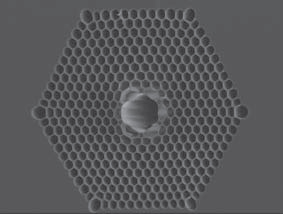Switching with a few photons for quantum computing
By Bill Steele

Quantum computing, where bits of information, or "qubits," are represented by the state of single atomic particles or photons of light, won't be of much use unless we can read the results. Cornell researchers have taken a step in that direction with a device that can measure the presence of just a few photons without disturbing them.
The experiment mixes a strong beam of light with a very weak "signal" beam consisting of fewer than 20 photons in such a way that the phase -- a measure of the timing of a wave -- of the strong beam changes in proportion to the number of photons in the signal.
"Ideally what people want is to be able to measure the presence of a single photon, without destroying it," said Alex Gaeta, professor and director of applied and engineering physics. "Nevertheless, there are interesting quantum information algorithms you can do with just a few photons." Switching a light beam with a single photon would be the equivalent of a "gate" in a conventional electronic computer, where a 1 or 0 input switches the output between 1 and 0. In future applications this could communicate the state of a qubit in a quantum computer, or the photons themselves might be the qubits.
The device created by Gaeta's research group makes use of a new type of optical fiber known as photonic bandgap fiber, which consists of a hollow core surrounded by a honeycomb of tiny glass tubes. The honeycomb acts as a diffraction grating that bends light in such a way that all wavelengths are canceled except for a narrow gap at the fundamental wavelength of the light to be transported, confining that light to an intense beam in the core. The advantage over conventional glass fiber is that the core can be filled with a gas.
In experiments reported in the Dec. 2 online issue of the journal Nature Photonics, the researchers filled the core of a fiber about 9 centimeters long with rubidium vapor to exploit what's known as the Kerr effect, in which the oscillating electromagnetic fields in a beam of light interact with the electromagnetic fields of the electrons in atoms to change the refractive index of the medium, which changes the way light is affected when it passes through. The weak signal beam changes the refractive index of the rubidium vapor enough to change the phase of the strong beam, which can be measured after the beam emerges from the fiber. The process is "nondestructive" in that the number of photons in the signal beam is not affected.
Varying the intensity of the signal, and thereby the number of photons, the researchers measured a phase change of about .3 milliradians (a unit of angle) per photon, suggesting that eventually single photons could be detected, and that such a device could be used to count photons. Varying the length of pulses of the strong beam showed that the system could respond in less than 5 nanoseconds, indicating that the strong beam could be modulated at frequencies up to 50 MHz.
Similar measurements have been performed in apparatus cooled to cryogenic temperatures, the researchers noted, but this is the first time it has been done at room temperature.
The research was supported by the National Science Foundation.
Media Contact
Get Cornell news delivered right to your inbox.
Subscribe